Spock, Kirk, Gorn — Oh My! How ‘Star Trek: Strange New Worlds’ Breathed Thrilling New Life Into the 56-Year-Old Franchise
- Oops!Something went wrong.Please try again later.
- Oops!Something went wrong.Please try again later.
- Oops!Something went wrong.Please try again later.
- Oops!Something went wrong.Please try again later.
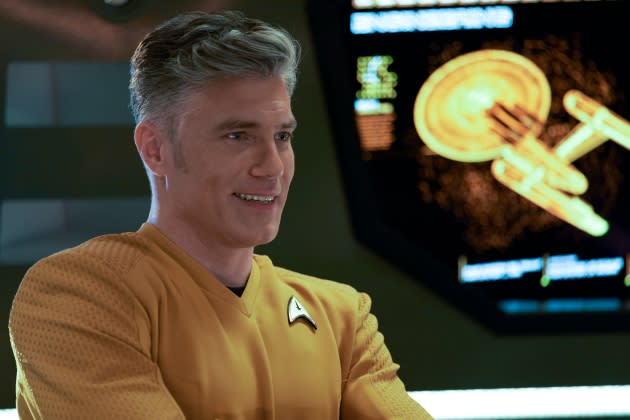
SPOILER ALERT: This story discusses major plot developments in several episodes of the first season of “Star Trek: Strange New Worlds,” including the season finale, currently streaming on Paramount+.
As with any fandom, Trekkies can be a fickle lot, which makes the enthusiastic reception for “Star Trek: Strange New Worlds” — the latest “Star Trek” TV series, which just concluded its first season — that much more remarkable. Not since J.J. Abrams’ 2009 feature film have fans been this near-unanimous in their appreciation, even adoration, for a new “Star Trek” venture, which is saying something in an era in which “Trek” fans have more viewing options than ever before.
More from Variety
'Picard' Stars React to Michelle Yeoh Returning to 'Star Trek' Universe: 'Talk About Badass!'
Paramount+ Greenlights 'Star Trek: Section 31' Film Starring Michelle Yeoh
For Henry Alonso Myers, executive producer and co-showrunner with the show’s co-creator Akiva Goldsman, the fan response has been gratifying — at least, as much as he’s allowed himself to experience it. “I’m a fan, so I go to the outlets that I like and listen to some things, and check Twitter every now and again,” he tells Variety. “But I also don’t want to let that into my head too much, because you’ll start to do things for the wrong reasons. Part of doing this job is delivering what fans want, but part of it is creating emotional experiences, and sometimes emotional experience is challenging.”
In its first season, “Strange New Worlds” ranks with “The Mandalorian” in striking a wildly successful balance for a new iteration of a legacy franchise between nostalgic fan service and bold, unexpected storytelling. Which isn’t to say that the series has pleased all the people all of the time.
Set on the U.S.S. Enterprise roughly a decade before the events of the original “Star Trek” TV series from the 1960s, “Strange New Worlds” includes vividly rendered younger versions of several classic “Trek” characters, such as Spock (Ethan Peck), Uhura (Celia Rose Gooding) and Nurse Chapel (Jess Bush), and it’s breathed robust new life into characters from the original “Star Trek” pilot, namely Capt. Christopher Pike (Anson Mount) and his first officer, Una Chin-Riley (Rebecca Romijn) — known as only Number One for decades until “Strange New Worlds” gave her a full name.
But with all of those previously established characters comes a fulsome set of fan expectations of how they should behave, and what the universe they inhabit should look and feel like. As a fan himself, Myers understood he had to tread carefully.
“When someone hands you a ‘Star Trek’ show, you can’t treat it like you’re going to break it all the time and only do what you think is safe,” Myers says. “If you do that, you’re not going to do a good show. That said, choosing to do things that might push the boundaries is going to bug people. I just don’t want that to scare them away.”
To get there, Myers, Goldsman and their team of writers had to learn how to transform one of the most common complaints fans have for a legacy series into an advantage.
“People will sometimes feel like you’re playing with people’s childhoods,” Myers says. “What has been a real freedom for me is to say, ‘I’m not playing with your childhood: The things from your childhood haven’t happened yet.’ I have to act like I don’t know what’s going to happen. Uhura doesn’t know who she’s going to be. Spock doesn’t know who he’s going to be. If you can accept that, you can understand that their experience is real and interesting and happening now.”
In an in-depth interview with Variety, Myers reflected back on some of the biggest highlights and challenges of the first season of “Strange New Worlds.”
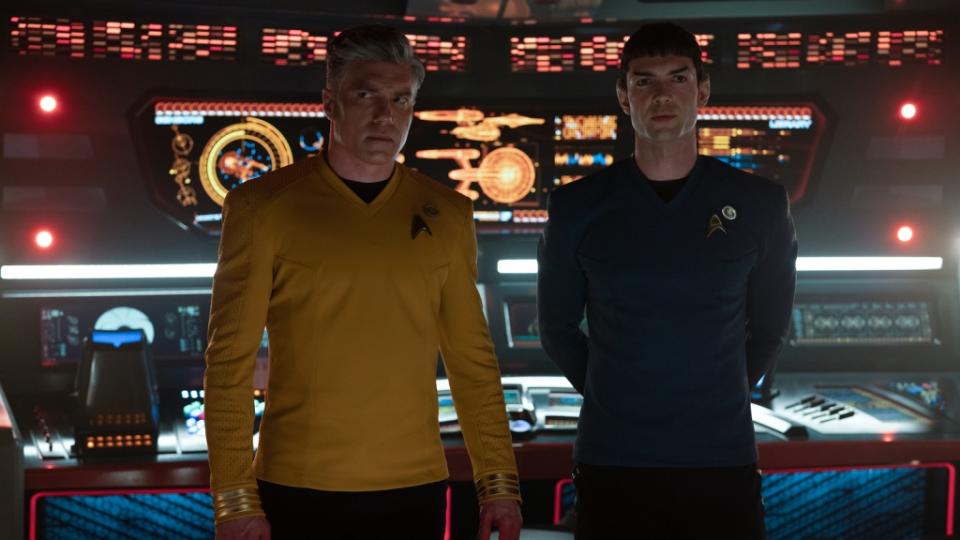
“We’re Just Gonna Try to Do Classic ‘Trek'”
When CBS All Access (now Paramount+) re-launched “Star Trek” as a television enterprise in 2017 with “Star Trek: Discovery,” it’d been 12 years since a “Trek” show was last on the air. In that time, serialized storytelling became the dominant narrative model for streaming dramas, especially genre ones; “Discovery” has followed suit, telling a single, ongoing story every season. Starting in 2020, “Star Trek: Picard,” a sequel series to “Star Trek: The Next Generation” starring Patrick Stewart, has done the same.
Fan response has been mixed. “Trek” has ventured into serialization before, with the 1990s series “Star Trek: Deep Space Nine,” and “Discovery” and “Picard” have taken full advantage of the opportunity to paint on a broader narrative canvass. But the original “Trek” series and “The Next Generation” remain among the most beloved — and re-watched — “Trek” series because they adhered to the old school, episodic structure of a brand new adventure every week.
“Telling a really long overarching story is so challenging,” Myers says. “You don’t often get little downtime moments.”
“Strange New Worlds” has forged a middle path, with each episode telling a self-contained story while threading longer character arcs that span multiple episodes — or occasionally, the whole season.
“The other ‘Star Trek’ shows are doing bigger, broader experiments, which I think are cool,” Myers says of “Discovery” and “Picard.” “They’re definitely trying to open up the sandbox and do different kinds of things with ‘Trek.’ We’re sort of the opposite. It’s a little easier to be like, ‘We’re just gonna try to do classic ‘Trek.'”
Myers cites “The Next Generation” and “Deep Space Nine” as the biggest touchstones for Goldsman and himself. “I think I was a little more in the ‘TNG’/’DS9’ world, and Akiva was a little more ‘TOS’ — and we found a way to meet in the middle,” he says. “When I thought about what kind of stories that I wanted to tell, that’s where I leaned.”
Most episodes of “Strange New Worlds” focused on one or two characters as the central driver of that week’s episode, and the self-contained storylines allowed the writers more breathing room to allow the characters to simply bounce off each other. “I love genre storytelling, but when it skimps on character, it just never works, and when it delivers on character, it makes everything work,” Myers says. “We get to relish the downtime moments. It’s the comforting part of television that you don’t always get out of movies. If we focus on character, the action will feel like it has more stakes, the romance will feel like it actually matters, and the humor will be funnier, because it’s coming from people that we know and like to hang out with. I think that that’s the thing that we’ve gotten to do a little more than other [‘Trek’] shows.”
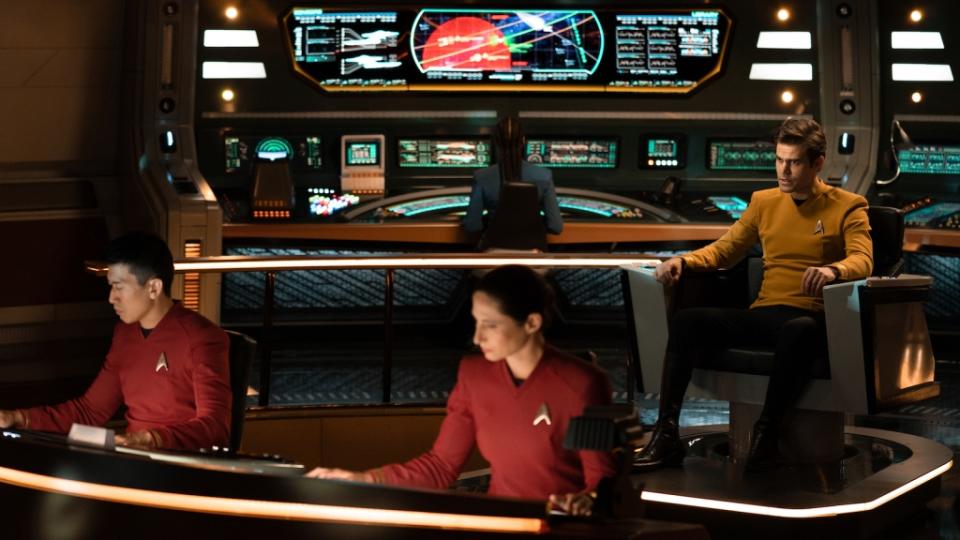
“We Didn’t Know if We Would Be Able to Get Kirk”
One of the most inflexible pieces of “Star Trek” canon is that until the original series episode “Balance of Terror,” it had been 100 years since anyone in the Federation had seen or heard from the Romulans — one of the most lasting and resonant “Trek” villains ever. The “Strange New Worlds” writers solved that problem with its season finale, “A Quality of Mercy,” which transported Capt. Pike into a future, alternate timeline in which he, not Capt. Kirk, was leading the Enterprise during the events of “Balance of Terror.”
The episode, Myers says, was the marriage of two ideas floating in the “Strange New Worlds” writers’ room. Idea one: “What if we took a classic ‘Trek’ episode and changed the timeline so we’re retelling that episode with our characters in a high-budget context?” Idea two: “What if your future self comes back and says, ‘Don’t do what you’re about to do’ — how would you respond?”
In the original series, we learn that Pike suffered a horrific, debilitating accident that removed him from command, allowing Kirk to take his place. On “Strange New Worlds,” Pike knows of his eventual fate, and in “A Quality of Mercy,” he tries to change it, causing his future self to appear and show Pike what will happen if he takes that path.
Placing Pike at the helm of the Enterprise when Kirk was meant to captain it also presented the tantalizing prospect of having the two men share the same scene — but that meant finding an actor to play Kirk. Myers says that after extensive auditions, they ended up offering the role to “The Vampires Diaries” star Paul Wesley, but the decision came down to the wire.
“Part of that episode ended up being about the differences of command the differences between Kirk and Pike and how they approach things very, very differently,” Myers says. “But there was a brief moment when we didn’t know if we would be able to get a Kirk. I wrote two versions of the script, one with Kirk and one without.”
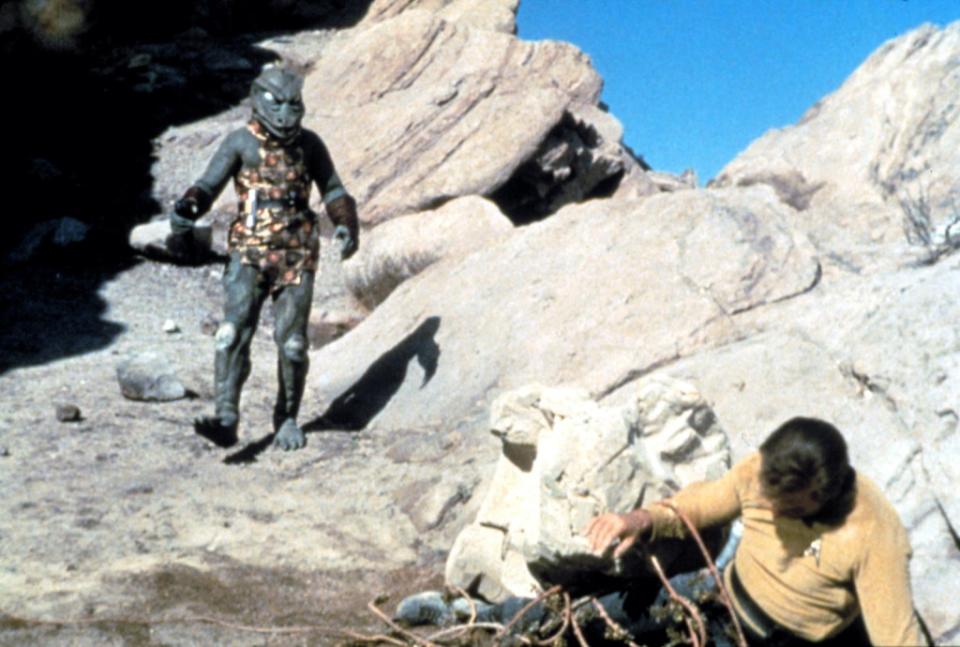
“There’s a Reason People Haven’t Touched the Gorn”
Along with the Romulans, there have been several alien races that have been used as central antagonists on “Star Trek” — the Klingons, the Borg, the Dominion — but “Strange New Worlds” dipped way back into “Trek” history for its Season 1 villains: the Gorn.
The reptilian aliens made their debut in an episode from the first season of the original series, “Arena,” in which Capt. Kirk (William Shatner) is pitted in a fight to the death on an alien planet against a Gorn captain. Since then, the species has occupied the fringes of the “Trek” universe, showing up again only fleetingly over the years, most often in animation. That’s because on the original series, the Gorn looked like, well, a man in a giant rubber lizard suit.
“You couldn’t do the Gorn now the way they did the Gorn,” Myers says. “I think audiences would have an instinctive organ transplant rejection to the classic version of the Gorn. Audiences now are sophisticated, they expect a certain level of effects work, of verisimilitude.”
But Myers says that Goldsman “has wanted to do something with the Gorn forever,” and made resurrecting the species a goal for Season 1 of “Strange New Worlds.”
“I mean, look, I love ‘Arena.’ ‘Arena’ is a great episode. But there’s a reason people haven’t touched the Gorn much since then,” Myers says. “They’re extremely hard to do. It’s expensive, it’s challenging. You have to reimagine them.”
Doing so meant bending “Trek” canon a bit, and reconceiving the Gorn as at once highly intelligent and yet feral in their primal, ferocious aggression. It also meant keeping the species largely off screen, since making them look realistic to 21st century eyes required a full, and costly, CGI redesign. The result maintained the feeling from “Arena” that the Gorn were unrelentingly dangerous while deepening their mythology enough to place them on par with the A-list of “Trek” alien adversaries.
“I’m aware of some of the the canon challenges,” Myers says. “Knowing that you’re going to have to change them is an opportunity to try to do something different.”
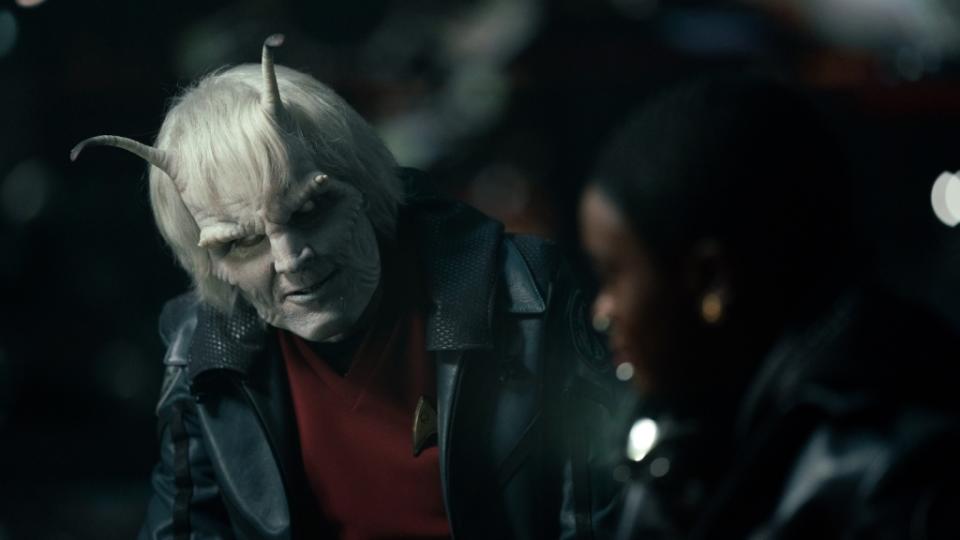
“We Wanted to Show That There Were Stakes”
Characters die all the time on “Star Trek,” but it remains exceedingly rare that it happens to a member of the main cast — and even then, it’s because the actor involved wanted to leave the show. That wasn’t the case with Hemmer (Bruce Horak), the irascible chief engineer on Enterprise who sacrifices himself at the end of Episode 9, “All Those Who Wander,” after his body is implanted with Gorn offspring. The writers knew from the start that they were going to kill Hemmer off.
“When we cast Bruce, we told him,” Myers says. “He was like, ‘Great. I’m down. This is awesome!'”
The issue, Myers explained, was that “Strange New Worlds” had to make clear the characters were at real risk. “One of the knocks on a prequel is that we know Uhura’s going to make it, we know Spock’s going to make it,” he says. “We wanted to show that there were stakes in this show.”
But quickly, they realized they had a problem. “We didn’t know that Bruce was going to be so wonderful,” he says. “We didn’t know we’d be so lucky to have been such a phenomenal actor. He had this relationship with Uhura that really opened up her story in a great way. I could have written Hemmer for, like, five seasons. But in a series where you only get 10 [episodes], that’s a real challenge.”
Don’t worry: While Hemmer is dead, the actor who played him is not gone. “We are finding and have currently found ways to have Bruce circle back in our universe in a very classic ‘Trek’ way,” he says. “It won’t be the last you see of Bruce Horak.”
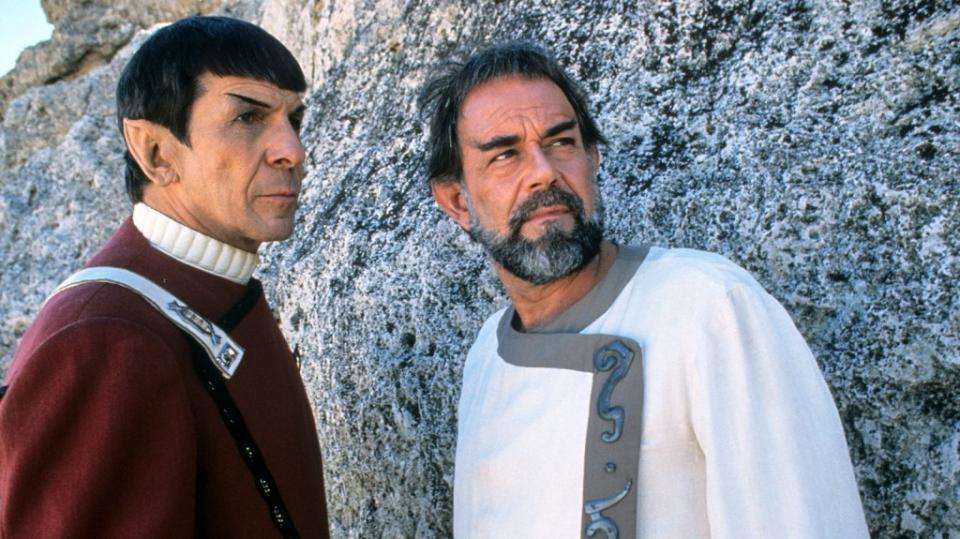
“It Was All About Telling the Story About Spock”
Perhaps the most surprising twist in Season 1 of “Strange New Worlds” was the revelation that Spock’s fiancée T’Pring (Gia Sandhu) is unknowingly overseeing a Vulcan prison that houses Spock’s half-brother, Sybok. The character was introduced as the main villain in the 1989 feature film “Star Trek V: The Final Frontier,” as played by Laurence Luckinbill (after Sean Connery couldn’t do it), but the movie is widely considered one of the worst “Trek” films ever, and the character has since faded into obscurity. (It didn’t help that Spock had never mentioned Sybok before “Star Trek V,” either.)
Myers can’t remember who had the idea to bring Sybok back into the “Trek” fold, but says it grew out of the conception of Episode 7, “The Serene Squall,” which centered on Angel (Jesse James Keitel), a nonbinary space pirate who befriends — and then betrays — Spock in an (initially successful) attempt to commandeer the Enterprise.
“We wanted to do a villain that harkened back to classic ‘Trek’ — a really fun, scenery-chewing villain who you just want to see again and again and again, but also could be a villain that we can only do now,” Myers says. “In doing a story about someone who’s nonbinary, it really tied into the story about Spock reckoning with his identity. The Sybok piece was an interesting way to tie into Spock’s past, and to reclaim a piece of ‘Trek’ lore.”
Despite Sybok’s dubious origins in “Star Trek V,” Myers and the writers liked that the character’s decision to forsake logic and embrace his emotions contrasted with Spock’s dogged pursuit of pure logic.
“You know, look, that movie is, uh — let me just say it’s not my favorite of the ‘Trek’ movies,” Myers says with a laugh. “But even in the ‘Trek’ movies that don’t work as well, there’s always something interesting. I liked that character, and the idea of a Vulcan who is wrestling with emotion. Science fiction is about playing with ideas. We’re not just moving chess pieces around.”
Sybok appears only from the back at the very end of “The Serene Squall,” and that’s the last we see of him in Season 1. But Myers is tight-lipped on when, or whether, he may show up again. “Sometimes you do these things in TV where you pull the thread just to see where it gets you,” he says. “You don’t have to wrap everything up. We wanted to throw out some more ideas that may come back and intersect with the show in the future.”
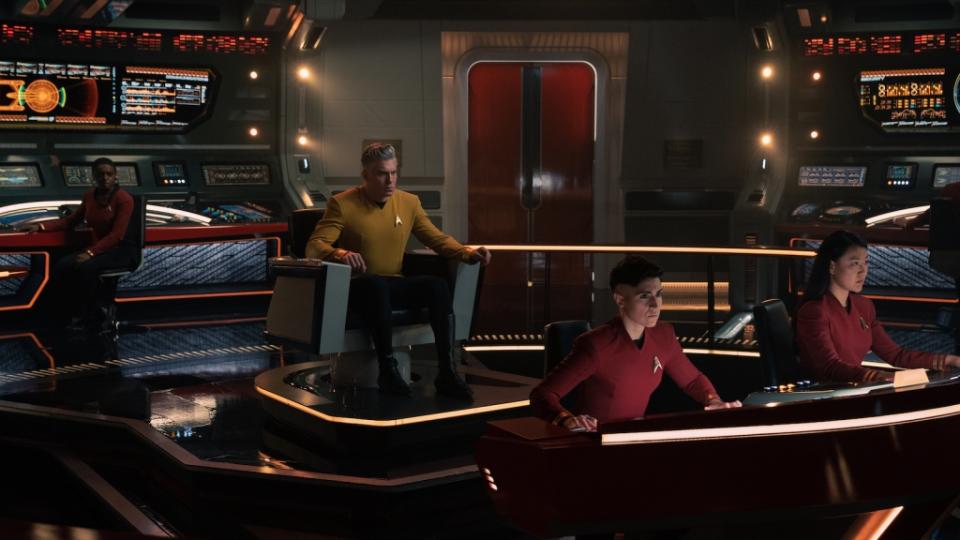
“This Is the Pike Show”
The future of “Strange New Worlds” is, at least in part, already written: The series wrapped production earlier this month on Season 2, and will feature Wesley as Kirk years before he becomes a Starfleet captain.
“The Kirk that we’re going to meet in Season 2 is a lieutenant who is on his way to becoming a first officer in the fleet,” Myers says. “He is not yet the person we’ve come to know, to the same extent that Uhura and Spock and Chapel are not yet the person that we that we come to know on the original series. There’s still some growth, and things that he’s going through that we want to explore.”
When Mount, Peck and Romijn were first cast, it was for Season 2 of “Discovery” — with no sense at the time that they would ever be spun-off into their own show. Now that Myers has actors for Kirk, Spock and Uhura, however, it’s hard to ignore the prospect of continuing the “Star Trek” story into the era of the original series.
“Look, I would love nothing more than to then to go all the way forward to the future, and eventually do that with them,” he says. “But there’s a lot of stories before that. I’ll tell you what Kirk isn’t: He isn’t the replacement captain. This is the Pike show. This is the Spock show. This is the Number One show. We have a lot of stories yet to tell with them. That said, who knows what the future holds. We would be so lucky to have that Enterprise.”
He pauses, and answers with a knowing glint in his eyes. “I think that that would be an unbelievably interesting experiment,” he says. “But I don’t want to put the cart before the horse, because I love this show. And I hope we get to do it for a while.”
Best of Variety
Sign up for Variety’s Newsletter. For the latest news, follow us on Facebook, Twitter, and Instagram.

